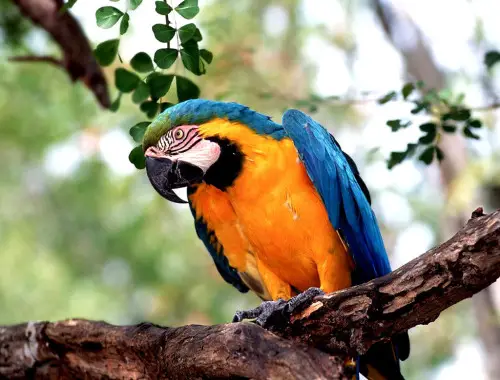Come and enjoy some of the most colorful and amazing facts about parrots for kids including parrot diet, habitat, reproduction, species, and its physical characteristics. Parrots are basically birds that belong to the order of Psittaciformes, along with 372 species in 86 genera. These types of colorful birds inhabit all across tropical and subtropical regions. A diverse range of these species are also found in the temperate regions in Southern Hemisphere, South America and Australia. The parrots can be easily recognized due to their robust bill, powerful legs, upright stance, and colored feathers. There is a great diversity in the plumage of all the species that ranges from white to the black. They vary in size, nature, appearance, and vocalizations. Parrot diet comprises buds, seeds, plants matter, and nuts. There are few species, however, that are adept to eat carrions and animals. The lorikeets and lories are known for feeding on soft fruits and floral nectar. These birds construct their nests in tree cavities or holes in which they lay white eggs. Of the birds species like jays, magpies and ravens, parrots are also one of the most intelligent birds and their special aptitude to mimic human voices make them popular among the pets community. On the negative side, the extensive trading, hunting, keeping in captivity and habitat loss makes them even invasive species with the decline of their population. The parrots may have been evolved in the Australasia as evident from its large presence in this part of the world. They are also present in great numbers across South America.
READ: Best 5 Large Cages for Cockatiels
Interesting Facts about Parrots For Kids
- There is a significant size variation in these species; the Buff-faced Pygmy Parrot weighs around 10 grams (0.4 oz), with the length measuring at 8 cm (3.1 inches) while the Hyacinth Macaw is 1 meter (3.3 feet) long, and the Kakapo weighs around 4.0 kg (8.8 lb).
- The species that are adaptable for eating seeds have relatively strong tongues. They have a strong curved bill with the upper mandible slightly longer than the lower.
- They have powerful feet that are usually employed for climbing and swinging. Besides, parrots also use their feet for eating.
- The population of several parrots is reducing due to excessive pet trading, hunting, and illegally keeping them in captivity. Of all the 350 species, more than 150 are listed as threatened by IUCN amongst which 16 species are regarded as critically endangered. Habitat loss and degradation are other prominent reasons for this much reduction.
- Parrots are also vulnerable to many species and the birds of prey are their most common natural predators.
Where Do Parrots Live | Parrot Habitat
Parrots inhabit all throughout the tropical and subtropical ranges of South America, Australasia, Central America, Africa, South Asia, Southeast Asia, and Oceania. Some of these species are the inhabitants of Pacific and Caribbean islands. However, the largest concentration of these colorful can be found in Australasia and South America. New Guinea also hosts quite a number of parrot species. Some other places where you can find these species are Bahamas, Mexico, New Zealand, Fiji, Solomon Islands, Philippines, Spain, United Kingdom, Belgium, and Tierra del Fuego.
Parrots for the most part have been of specific interest to mankind perhaps due to their popularity as pets. Parrots are particularly widespread all along the lowland tropical forests and as we move towards the edges of forests, we find increased numbers probably due to the watercourse or tracks which they mainly prefer. Besides, this specific habitat location is also preferred due to the fact that they can observe things quite clearly from here. Although there are some birds that are primarily known as forest-dwelling species but parrots mostly like wide broader regions for their habitats. They do not like to live at lofty regions. Amazona amazons fancy their living either in dry forests or in seasonally inundated wet forests. Some parrot habitat can be found in grasslands and shrubs.
What Do Parrots Eat | Facts about Parrots For Kids
Parrots predominantly feed on seeds, nuts, buds, fruits, nectar and also sometimes arthropods. The parrot diet also includes carrion, insects, and few animals. However, cockatoo, African grey parrots and other true parrots are widely known to feed on these seeds, buts, and buds. Some species are exclusively feed on nectar. Hanging parrots, Swift Parrots, Lories and lorikeets, are few of these birds. There are some parrots that consume animals and invertebrates. The golden-winged parakeets are widely known to prey on snails, petrels, Keas of New Zealand, and also prey on sheep. Most of the parrots diet is composed of grubs and insects.
Breeding | Fun Facts about Parrots For Kids
These species are not territorial birds and are typically considered to be monogamous breeders. The Monk Parakeets build their habitats in tree cavities while other species are regarded as ground-dwelling species as they make habitats on the ground. Some species employ abandoned nests of termites. The burrows are 0.5 – 2.0 meters (1.6 – 6.6 feet). The materials used for constructing nests are wood chips, sticks and other plants matter. Some parrots are adept to form in large colonies that consist of about 70,000 individuals. Females are normally responsible incubating eggs. The period of incubation lasts for 17 – 35 days; however, larger parrots have longer incubation periods. The juveniles stay in their nests for about 3 – 4 weeks even though it varies with species.
Amazing Facts about Parrots For Kids | Video


Leave a Reply